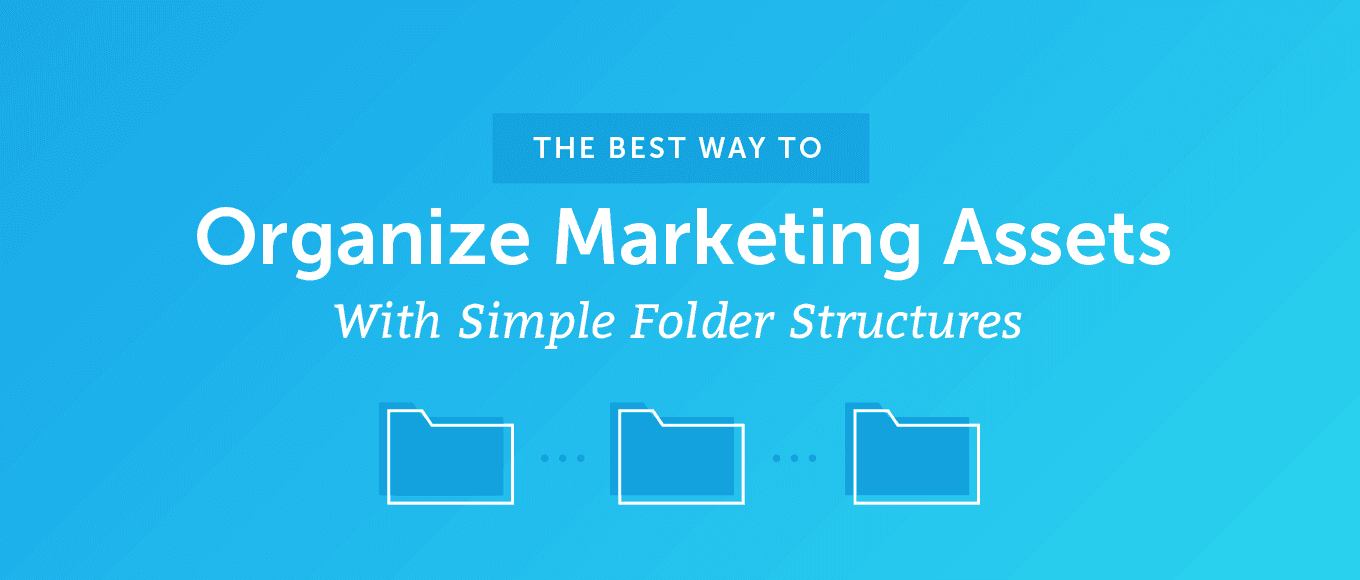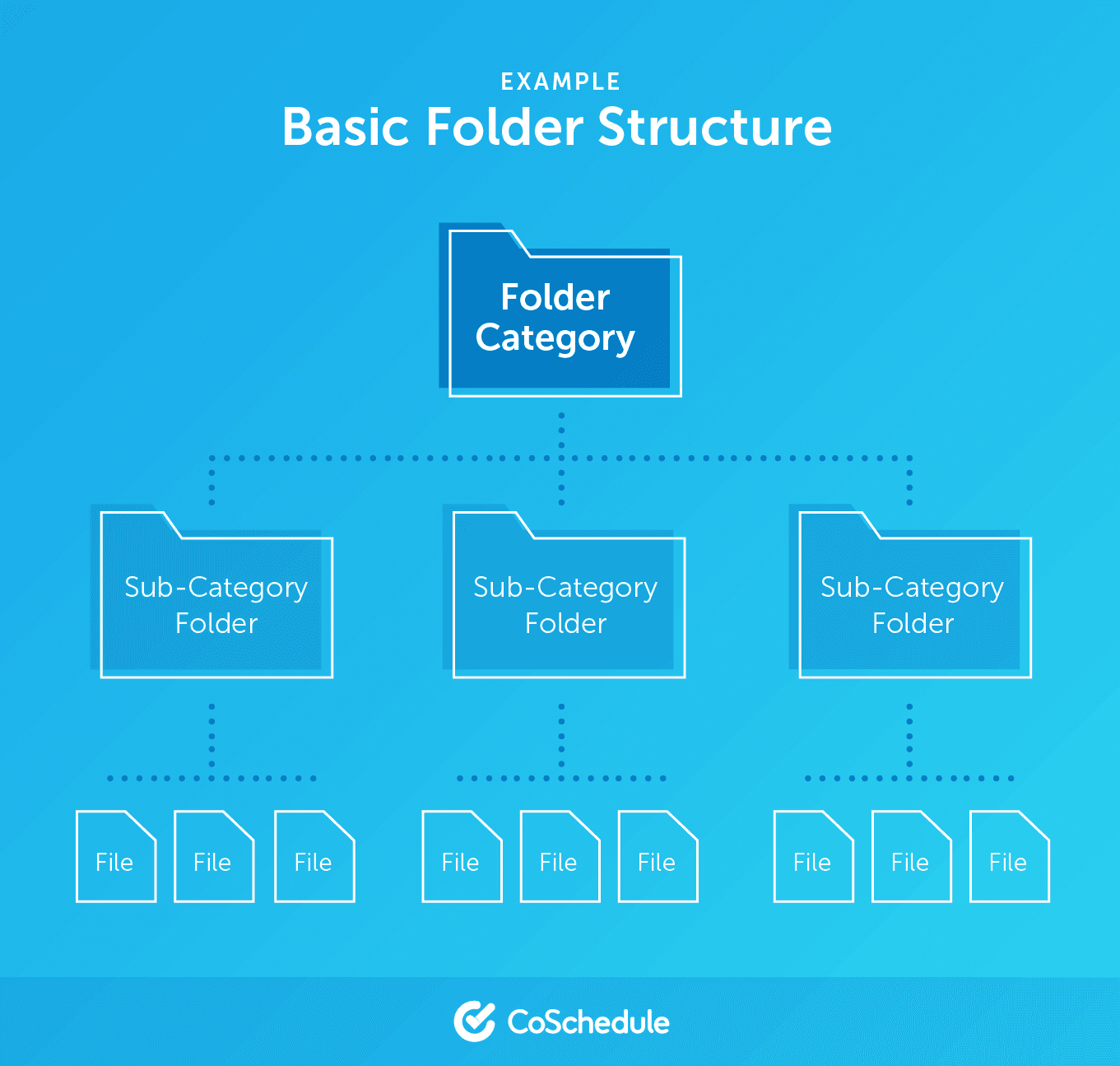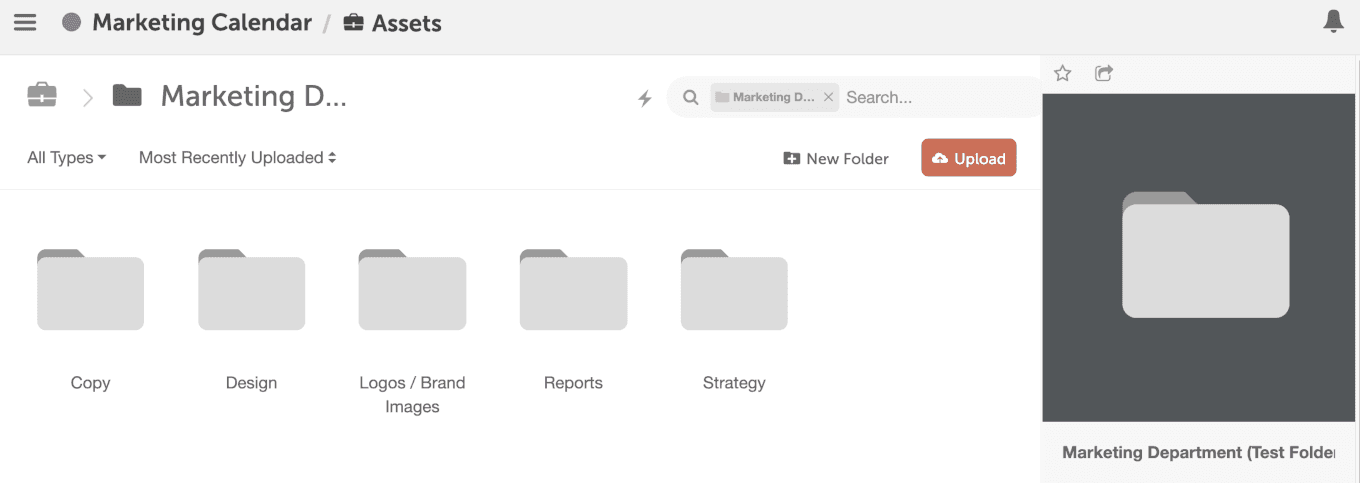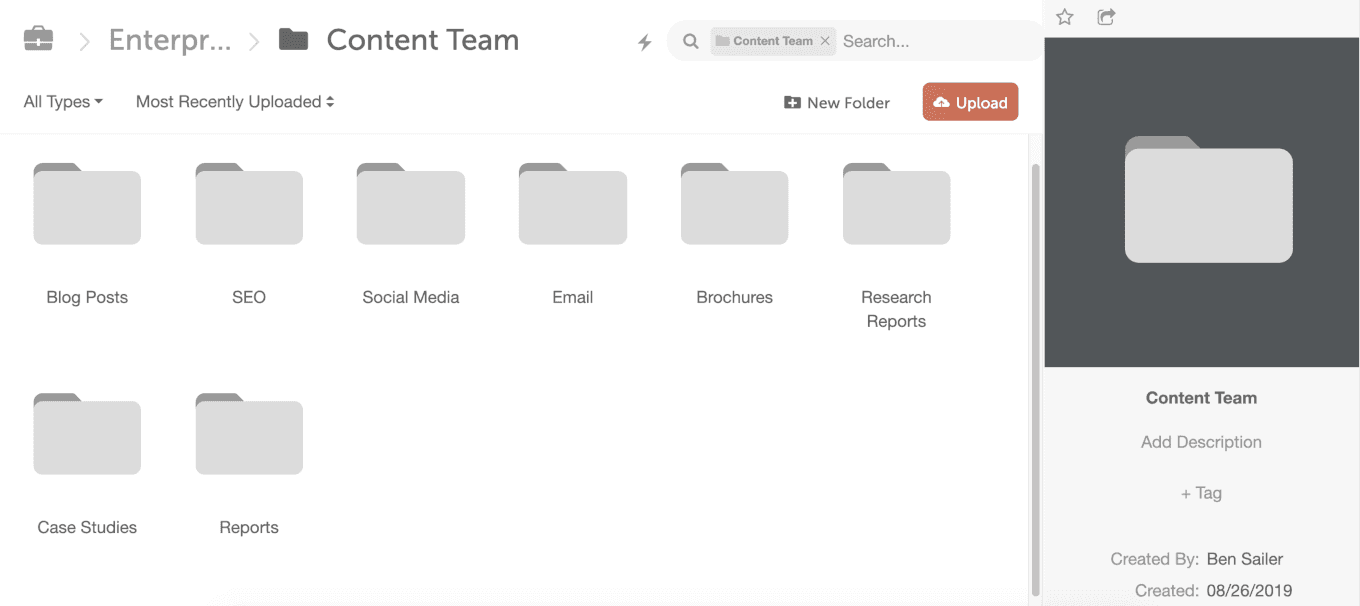The Best Way to Organize Marketing Assets With Simple Folder Structures
 Setting up clear company folder structures with your marketing team might seem like a trivial detail. However, if you’ve ever dealt with hassles in trying to find important assets you need for projects, then you know how disorganized files can lead to bigger problems later.
For example, think of how much time is getting wasted right now because team members can’t quickly track down things they need. Multiply that aggravation and loss of productivity times the number of times anyone on your team needs to do almost literally anything, and you can quickly see how disorganization compounds over time.
Plus, research shows organized marketers are 397% more likely to report success, and there’s no easier way to get organized than to start with your folder system. Whether you’re using a DAM or cloud storage service, this post will help you get it organized for good.
While it’s difficult to know the exact best way to structure folders within any single organization (without actually spying on your computer), there are some basic ideas and examples you can follow to get started with getting organized. And that’s what you’ll find in this post.
Setting up clear company folder structures with your marketing team might seem like a trivial detail. However, if you’ve ever dealt with hassles in trying to find important assets you need for projects, then you know how disorganized files can lead to bigger problems later.
For example, think of how much time is getting wasted right now because team members can’t quickly track down things they need. Multiply that aggravation and loss of productivity times the number of times anyone on your team needs to do almost literally anything, and you can quickly see how disorganization compounds over time.
Plus, research shows organized marketers are 397% more likely to report success, and there’s no easier way to get organized than to start with your folder system. Whether you’re using a DAM or cloud storage service, this post will help you get it organized for good.
While it’s difficult to know the exact best way to structure folders within any single organization (without actually spying on your computer), there are some basic ideas and examples you can follow to get started with getting organized. And that’s what you’ll find in this post.
The Best Way to Organize Marketing Assets With Simple Folder Structures
Click To TweetDownload: A Clear and Simple Folder Structure Template for Marketers
In order to expedite getting organized, download this collection of pre-made folders. They’re labelled and structured to fit the needs of most marketing teams (and of course, they’re easy enough to adjust in any way you need—they’re nothing too crazy, but they should make your life a little bit easier).What Should a Good Marketing Team’s Folder Structure Include?
Before you can establishing what your folder system needs, it’s helpful to know what problems you’re trying to solve. Some of those include:- Stop wasting time looking for things. And spend more time doing actual work.
- Avoid losing track of important assets and documents. It can happen easier than you might think.
- Help your team be more successful on the job. Work with less stress and improve your odds for success.
- A defined folder hierarchy. This will make your folders easier to navigate.
- One clear destination for every file. Make knowing what goes where easy.
- Alignment with your workflows. This means having folders for different tasks, projects, and clients, depending on what makes the most sense for how you work.
Example of a Basic Folder Structure
What does a folder system look like when it’s fully diagrammed? Here’s a simple illustration to help you visualize what we’re talking about: In this example, you’ll see a few things:
In this example, you’ll see a few things:
- A top-level folder. This might be for a client, campaign category, or project type.
- Several sub-category or project-level folders. These would be files associated with a specific project or campaign.
- Well-organized files within each sub-folder. With each one given a clearly-defined file name (more on this later).
A Simple Philosophy For Planning a Folder Hierarchy
Separate from the specific labels you use with your folders, there’s a basic philosophy that can drive how you keep everything organized. It’s as easy as starting with your biggest bucket first, and then prioritizing downward from there. Figuring out how this should look takes a little bit of time and some common sense logic, but not much more than that. Here’s a rudimentary template to follow:- 1st Level: The absolute highest-level, widest-reaching bucket you have.
- 2nd Level: Specific categories of teams, people, or projects.
- 3rd Level: Same as above, but more granular (if necessary).
- 4th Level: Consider adding folders for files by the month or year they were created.
- 5th Level: Individual files.
First, Give Your Team a Centralized Destination for Files and Assets
Marketing teams commonly store files in multiple places. Different sub-teams will have their own storage processes, or different clients will want to work with different tools. Whatever the case may be, this can make finding what you need difficult. That’s particularly true in large organizations and agencies where team members might need to get IT approval or permission to access different tools to get what they need. In short, a simple problem can turn into a massive headache quickly. No matter the size of your team or company though, making it clear where certain things can be found is a major quality-of-life consideration to take care of. And you’ve got some options here.Choosing Cloud-Based Storage and Digital Asset Management Software
Your company probably already uses some type of cloud storage. You might even have some sort of DAM (digital asset management) solution too. If not, here are some options to consider:- Google Drive: Almost ubiquitous in the business world today. Integrates with CoSchedule.
- Dropbox: Another popular cloud storage option with strong business features. Also integrates with CoSchedule.
- Asset Organizer: CoSchedule’s DAM solution built specifically for marketers.
Next, Figure Out Your Team’s Workflows
How does your team typically work day-to-day? Start by asking a few questions:- How are your teams and departments constructed? This will help determine whether it makes sense to have team and department-level folders.
- Do team members typically work individually or collaboratively? If team members will need to share folders frequently, then using a storage solution that makes folder-sharing easy will be important.
- Are files and folders frequently shared between team members and external stakeholders? Same as above. Having your files stored in something that makes it easy to set sharing permissions can help avoid a lot of headaches.
Developing Your Own Folder Structure
Once you have a basic understanding of what your team needs, you can start plotting out a structure for your folders. What this looks like specifically will depend on your particular situation, but what follows is a simple process to figure this out.Start With Top-Level Folders
Your folders should cascade downward in a logical fashion that starts with the highest-level needs of your organization. Additional folders can filter more narrowly from there. That might include:- Year. For the sake of easily finding things later, breaking folders down into years (and even months) can be beneficial.
- Departments. If you have multiple marketing departments (with multiple teams within each one).
- Teams. One folder for your marketing department (with sub-folders for each sub-team).
- Clients. For agencies and consultants working with multiple clients.
Next, Add Sub-Folders
Within each top-level folder, add in necessary sub-folders. Depending on what you’ve set as your parent folder, it might make sense to narrow these down by some of the following:- Individual client folders. For agencies and consultants working with multiple clients.
- Individual sub-teams. If you have one overarching marketing department with several smaller teams within it.
- Campaign or project types. Organized by campaign or project categories (ex: Copy, Design, Reports, etc.).
- Asset types: Ex: copy, design, videos, etc.
Consider Adding Team Member-Level Folders
At the team member level, people should be able to control their own folders (and this post will cover organizing personal files later on). But, if you have files that a team members “owns,” but others might need to access, creating folders for each team member may be a good idea. For example, designers might keep a folder for everything they create, but they might also keep them in a shared folder in case someone else needs to use or access those assets for a project. In this case, your absolute most bottom-level folders could belong to individual team members. If your top-level folders represent your entire department, then at this point, you’ve worked your way the entire down the org chart to the most molecular level of the hierarchy.Department-Wide Folder Organization Examples
Your marketing department likely has plenty of files and folders you need to share with one another.Option 1: Startup and SMB In-house Marketing Folder Structure
If you’re working with a small team, then keeping everything organized might not be too difficult. But, that doesn’t mean it isn’t important to get this right. Here’s a basic layout that breaks down projects by type: Here are some ideas for subfolders within each one:
Copy:
Here are some ideas for subfolders within each one:
Copy:
- Website Content
- Landing Pages
- Social Media Posts
- Email Newsletters
- Press Releases
- Social Media Images
- Website Images
- Email Headers
- Landing Page Design
- Content Strategy
- Marketing Strategy
- Channel-Specific Strategies
- Logos
- Stock Images
- Office Images
- Content Reports
- Social Reports
- Email Reports
- Quarterly Reports
- Annual Reports
Option 2: Enterprise In-house Marketing Folder Structure for Multiple Sub-Teams
Larger organizations with multiple marketing departments or sub-teams will have more complex folder structuring needs. Here’s what this might look like within a large marketing department that includes several sub-teams: The folder structure within each team would get a bit more complex than the previous example as well. Here’s what might make sense within each team (some teams may have similar folders, but separated out to keep their stuff organized):
Content:
The folder structure within each team would get a bit more complex than the previous example as well. Here’s what might make sense within each team (some teams may have similar folders, but separated out to keep their stuff organized):
Content:
- Blog
- SEO
- Website
- Social Media
- Brochures
- Research Reports
- Case Studies
- Reports
- Press Releases
- Outreach
- Influencer Contacts
- Media Contacts
- Blog
- Website
- Social Media
- Coverage Reports
- Ads
- Social Media
- Website
- Blog
- PR
- Campaigns
- Ad Copy
- Ad Design Assets
- Keyword Data
- Budget
- Research
- Reports
- Time Charts
- Resource Tracking
- Productivity Reports
- Logos
- Stock Images
- Office Images
 Here, you can see a folder for each content type the team routinely creates. Next, they have a few options for how they might break down further folders:
Here, you can see a folder for each content type the team routinely creates. Next, they have a few options for how they might break down further folders:
- Year and month folders. Would it make the most sense to organize chronologically?
- Campaign-based folders. Keeping pieces for individual campaigns might make sense (for example, copy docs per social media campaign).
- Team member folders. A folder for each team member might make sense in some cases (like a folder for each writer’s blog posts, further broken down by individual posts).
Option 3: Agency Marketing Team Folder Structure
Agencies have unique client collaboration needs to consider. The way you structure your folders can be similar to in-house teams, but with some additional layers to keep client projects cleanly separated. At the highest level, an agency might consider folders divided between client and internal assets, plus other categories they might need: Within your client and internal files, the rest of the hierarchy might look similar to an inhouse or enterprise team. The key distinction is ensuring client and internal files and assets are kept separate and cleanly organized. This is especially important when your client deliverables are literally equal to money in the bank.
Within your client and internal files, the rest of the hierarchy might look similar to an inhouse or enterprise team. The key distinction is ensuring client and internal files and assets are kept separate and cleanly organized. This is especially important when your client deliverables are literally equal to money in the bank.
Organizing Personal Folders
For files and things you need for your own work purposes, it’s not a bad idea to have a clear structure for those as well. In fact, even if you’re not able to influence your entire department to make broad organizational changes (and sometimes changing something as simple as a file folder hierarchy can feel like moving mountains), you can at least control how your own things are organized.Some Basic Tips to Get Started
There are a few basic tips that, even if you do nothing else, can make a meaningful difference in keeping yourself organized.- Keep your files within the Documents folder on your computer. It’s better than having them strewn about wherever.
- Don’t use your desktop for long-term storage. It isn’t super secure and it’s inherently disorganized.
- Name your files something you’ll recognize later. Even if no one else ever needs to understand what a particular file might be just by looking at it, avoid confusing yourself later and stick to some sort of file naming convention.
An Example of a Working Personal Folder Structure
Establishing a simple folder hierarchy for yourself isn’t too difficult, but staying disciplined enough to maintain it over time can be challenging. So, make it easy on yourself by keeping it simple. In your documents folder, set something up for each project and content type you usually work on: Next, break these down into individual sub-folders based either on month and year, or specific campaigns, depending on what makes the most sense for you. Here are some suggestions:
Next, break these down into individual sub-folders based either on month and year, or specific campaigns, depending on what makes the most sense for you. Here are some suggestions:
- Blog Posts: By post type (how-to, case study, news, etc.)
- eBooks: A folder per book, including all the assets for each one.
- Email: By campaign or by month (for recurring sends like newsletters).
- Social Media: Folders for campaigns (if you’re writing copy in Word docs).
- Research: One folder per report.
- Analytics Reports: By report type, then broken down year and month.
- Website Content: By page type.
Manage Files With CoSchedule’s Asset Organizer
Ready to organize all your team-wide marketing files and assets? Store, index, and share your content with CoSchedule’s Asset Organizer, a digital asset management solution created for and by marketers.


